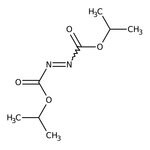Search Thermo Fisher Scientific
Thermo Scientific Chemicals
Diisopropyl azodicarboxylate, 94%, Thermo Scientific Chemicals
Catalog number: L10386.22
100 g, Each



Thermo Scientific Chemicals
Diisopropyl azodicarboxylate, 94%, Thermo Scientific Chemicals
Catalog number: L10386.22
100 g, Each
Quantity
Catalog number: L10386.22
also known as L10386-22
Price (USD)
Price: 112.00
Your price:
Quantity
-
Chemical Identifiers
CAS
2446-83-5
IUPAC Name
N-{[(propan-2-yloxy)carbonyl]imino}(propan-2-yloxy)formamide
Molecular Formula
C8H14N2O4
InChI Key
VVWRJUBEIPHGQF-UHFFFAOYSA-N
SMILES
CC(C)OC(=O)N=NC(=O)OC(C)C
Specifications
Appearance (Color)
Clear, orange to reddish brown
Form
Liquid
Assay (GC)
≥ 92.0%
Description
Diisopropyl azodicarboxylate is used as an important reagent in the production of many organic compounds. It is used in association with triphenyl phosphine in Mitsunobu reaction of alcohols, acids and amides. It acts as reactant in the preparation of chromenes resembling classical cannabinoids, norbornene-based guanidine-rich polymers and acceptor-donor-acceptor organic dyes.
This Thermo Scientific Chemicals brand product was originally part of the Alfa Aesar product portfolio. Some documentation and label information may refer to the legacy brand. The original Alfa Aesar product / item code or SKU reference has not changed as a part of the brand transition to Thermo Scientific Chemicals.
Applications
Diisopropyl azodicarboxylate is used as an important reagent in the production of many organic compounds. It is used in association with triphenyl phosphine in Mitsunobu reaction of alcohols, acids and amides. It acts as reactant in the preparation of chromenes resembling classical cannabinoids, norbornene-based guanidine-rich polymers and acceptor-donor-acceptor organic dyes.
Solubility
Immiscible with water.
Notes
Store in cool place. Light sensitive. Incompatible with strong oxidizing agents, strong bases, alcohols and metallic salts. Decomposes violently at or above: 100 0C.
Diisopropyl azodicarboxylate is used as an important reagent in the production of many organic compounds. It is used in association with triphenyl phosphine in Mitsunobu reaction of alcohols, acids and amides. It acts as reactant in the preparation of chromenes resembling classical cannabinoids, norbornene-based guanidine-rich polymers and acceptor-donor-acceptor organic dyes.
Solubility
Immiscible with water.
Notes
Store in cool place. Light sensitive. Incompatible with strong oxidizing agents, strong bases, alcohols and metallic salts. Decomposes violently at or above: 100 0C.
RUO – Research Use Only
Figures
Documents & Downloads
Certificates
Search by lot number or partial lot number
Frequently asked questions (FAQs)
Citations & References
Search citations by name, author, journal title or abstract text